HashiCorp Certified: Vault Operations Professional 2022
Build Fault Tolerant Vault Environments
Demo Disaster Recovery DR Replication
In this guide, you’ll configure Disaster Recovery (DR) replication across two Vault Enterprise clusters. We assume both single-node clusters are already initialized, unsealed, and you’re logged in as root:
- Primary (10.1.101.199, tan background)
- Secondary (10.1.101.108, white background)
DR replication requires Vault Enterprise; it is not supported in the open-source edition.
1. Check Current Replication Status
On the primary (10.1.101.199), confirm DR and performance replication are disabled:
ec2-user@ip-10-1-101-199 vault]$ vault read sys/replication/status
Key Value
--- -----
dr map[mode:disabled]
performance map[mode:disabled]
2. Enable DR Replication on Primary
Enable DR replication in primary mode:
ec2-user@ip-10-1-101-199 vault]$ vault write -force sys/replication/dr/primary/enable
WARNING! The following warnings were returned from Vault:
* This cluster is being enabled as a primary for replication. Vault will be unavailable for a brief period and will resume service shortly.
Note
Enabling primary DR replication causes a short downtime. Plan accordingly for production environments.
Verify that DR is now primary:
ec2-user@ip-10-1-101-199 vault]$ vault read sys/replication/status
Key Value
--- -----
dr map[cluster_id:65b5025a-b5ee-67de-6df6-6b2033dc75ed mode:primary state:running ...]
performance map[mode:disabled]
Or view as JSON:
ec2-user@ip-10-1-101-199 vault]$ vault read -format=json sys/replication/status | jq
{
"data": {
"dr": {
"cluster_id": "65b5025a-b5ee-67de-d6f6-6b2033dc75ed",
"mode": "primary",
"state": "running",
"known_secondaries": [],
...
},
"performance": {"mode":"disabled"}
}
}
3. Generate a Secondary Token
Still on the primary, create a one-time wrapping token for the secondary:
ec2-user@ip-10-1-101-199 vault]$ vault write -f sys/replication/dr/primary/secondary-token id=secondary-dallas
Key Value
--- -----
wrapping_token [C|JeHAiOjE2NTM0MTIxOTIsImlhdC1hIGB...]
wrapping_token_ttl 30m
wrapping_creation_path sys/replication/dr/primary/secondary-token
Copy the wrapping_token value (valid for 30 minutes).
4. Enable DR Replication on Secondary
Switch to the secondary (10.1.101.108) and join it to the primary:
[root@ip-10-1-101-108 vault]# vault write -f sys/replication/dr/secondary/enable token=<WRAPPING_TOKEN>
WARNING! The following warnings were returned from Vault:
* Vault has successfully found secondary information; it may take a while to perform setup tasks. Vault will be unavailable until these tasks and initial sync complete.
Warning
Enabling DR on a secondary will wipe any existing data. Be sure this node is dedicated for DR replication.
5. Verify DR Status on Secondary
On the secondary, confirm replication is active:
[root@ip-10-1-101-108 vault]# vault read -format=json sys/replication/status | jq
{
"data": {
"dr": {
"cluster_id": "65b5025a-b5ee-67de-6b2033dc75ed",
"mode": "secondary",
"state": "stream-wals",
"connection_state": "ready",
"secondary_id": "secondary-dallas",
"known_primary_cluster_addr": ["https://10.1.101.199:8201"],
...
},
"performance": {"mode":"disabled"}
}
}
A DR secondary does not serve client requests—most paths are disabled.
6. Verify DR Status on Primary
Back on the primary, list known secondaries:
[root@ip-10-1-101-199 vault]# vault read -format=json sys/replication/status | jq
{
"data": {
"dr": {
"mode": "primary",
"state": "running",
"known_secondaries": ["secondary-dallas"],
"secondaries": [
{
"api_address": "http://10.1.101.108:8200",
"cluster_address": "https://10.1.101.108:8201",
"connection_status": "connected",
"node_id": "secondary-dallas",
...
}
]
},
"performance": {"mode":"disabled"}
}
}
7. DR Replication in the UI
Primary Cluster Dashboard
Log in to the primary UI and go to Status → Disaster Recovery.
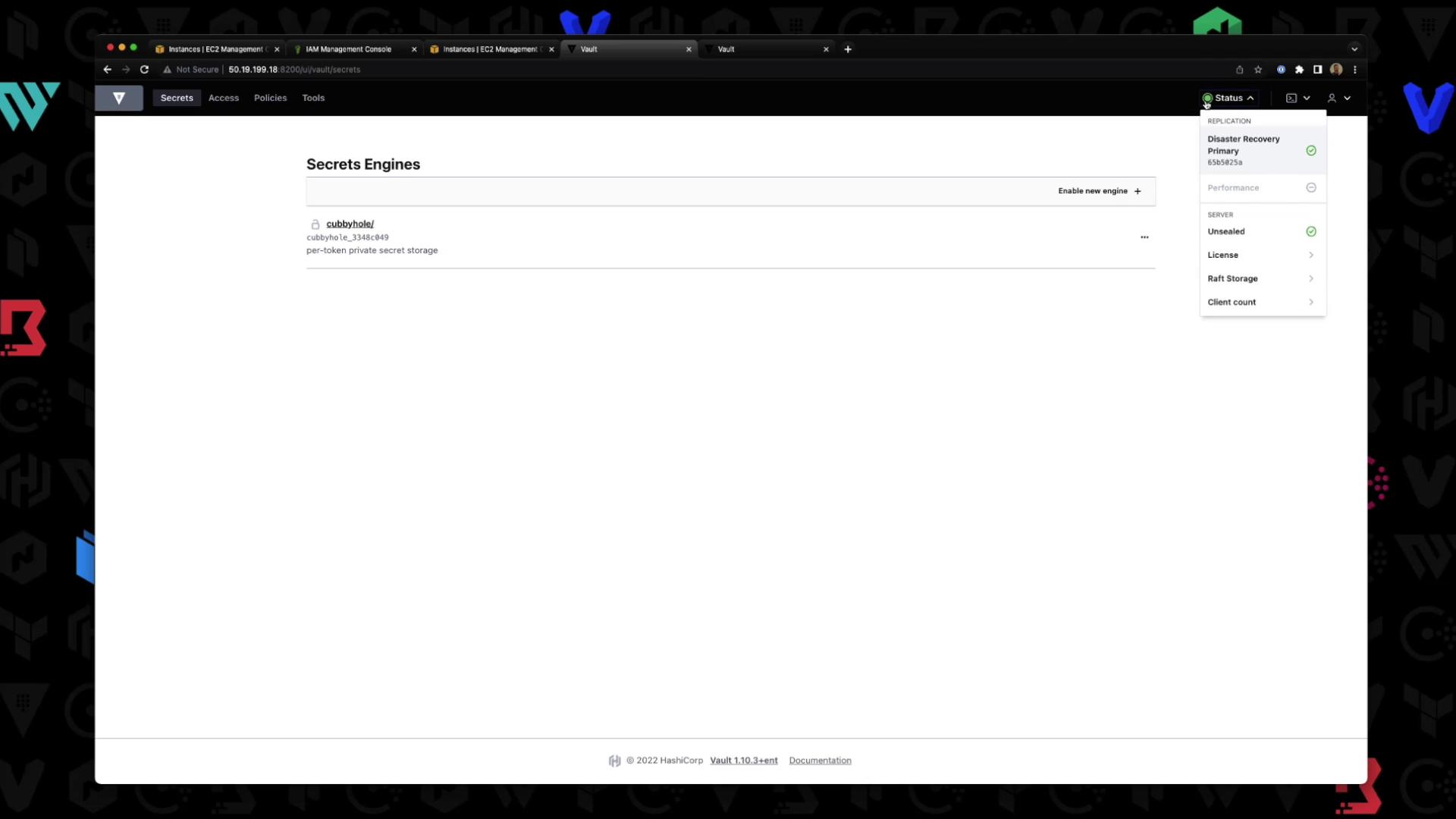
Click Disaster Recovery to view replication details:
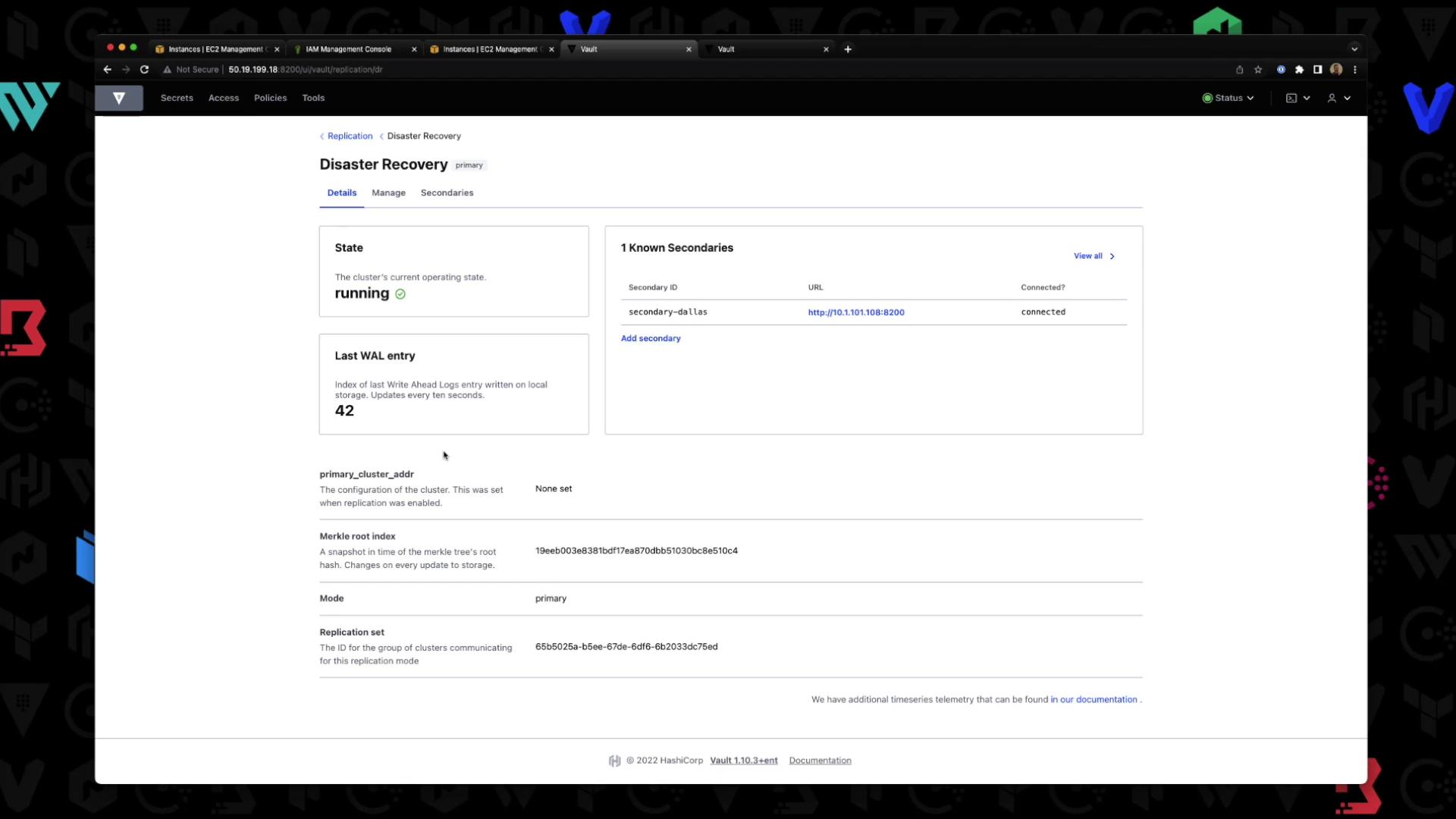
Under Manage, you can disable replication, force a re-index, or demote this primary:
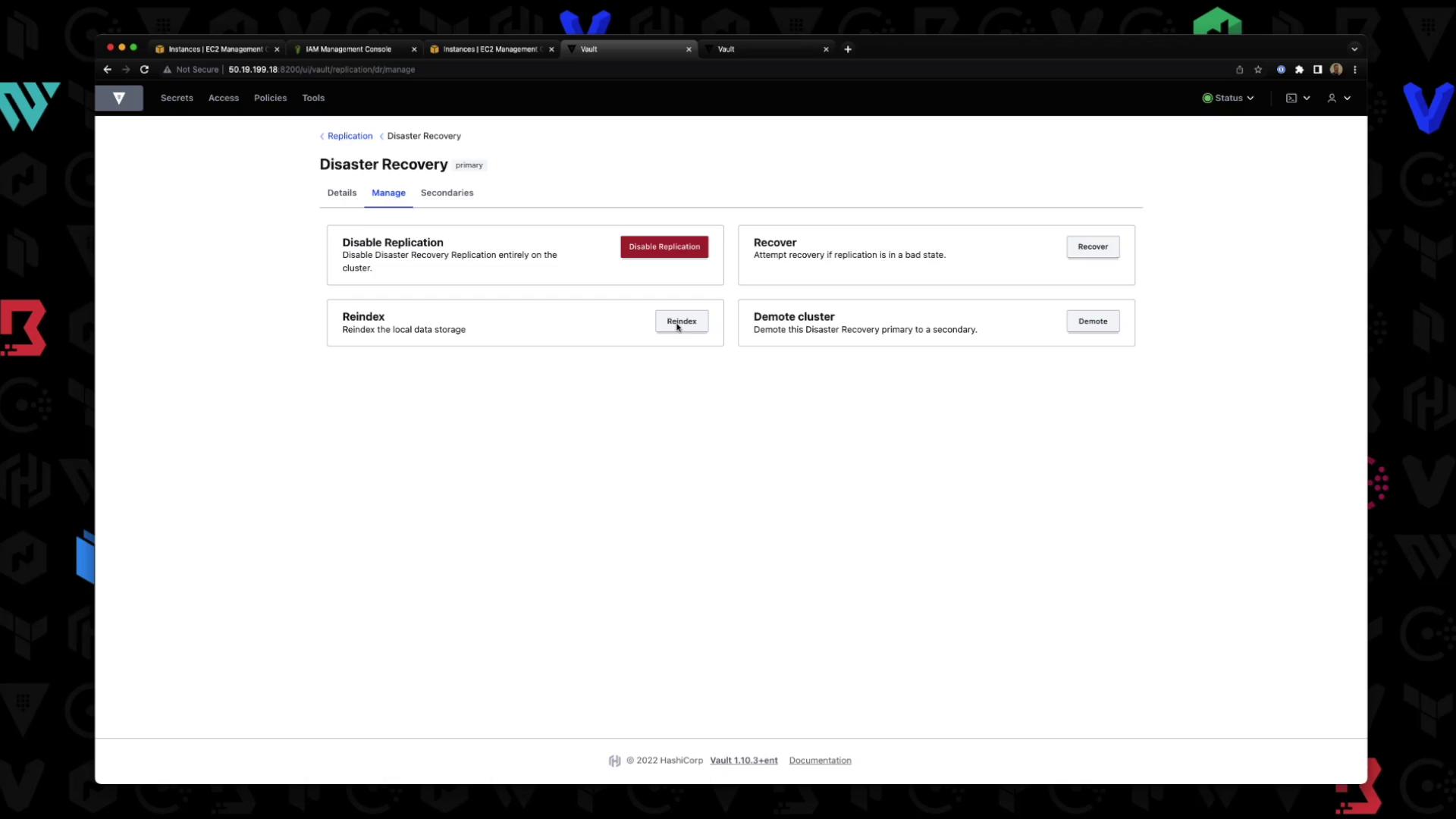
Secondary Cluster Dashboard
On the secondary UI, you’ll land directly in the DR dashboard (no login prompt). It shows the cluster in stream-wals state:
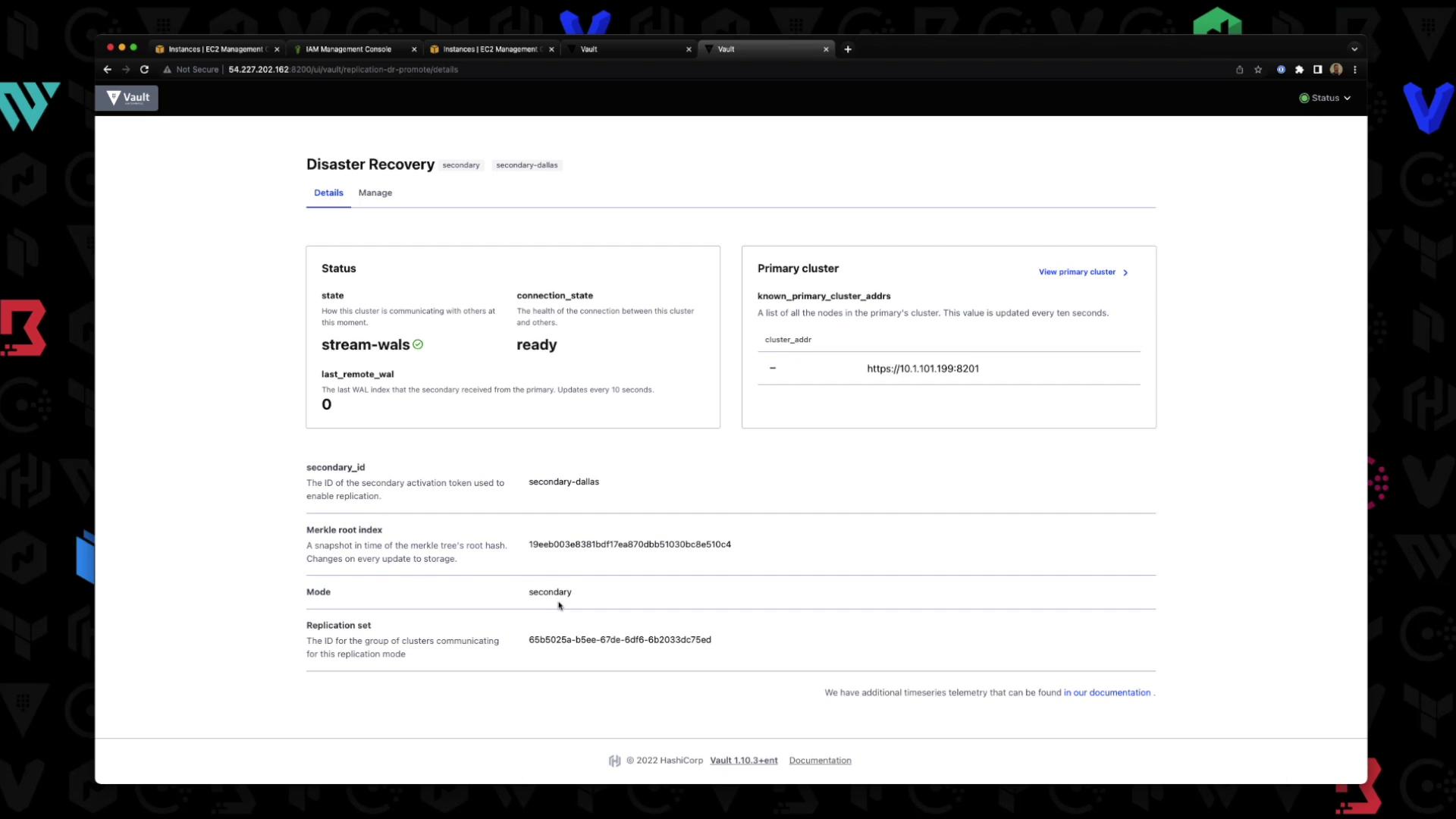
Under Manage, you can promote this secondary or generate an operational token:
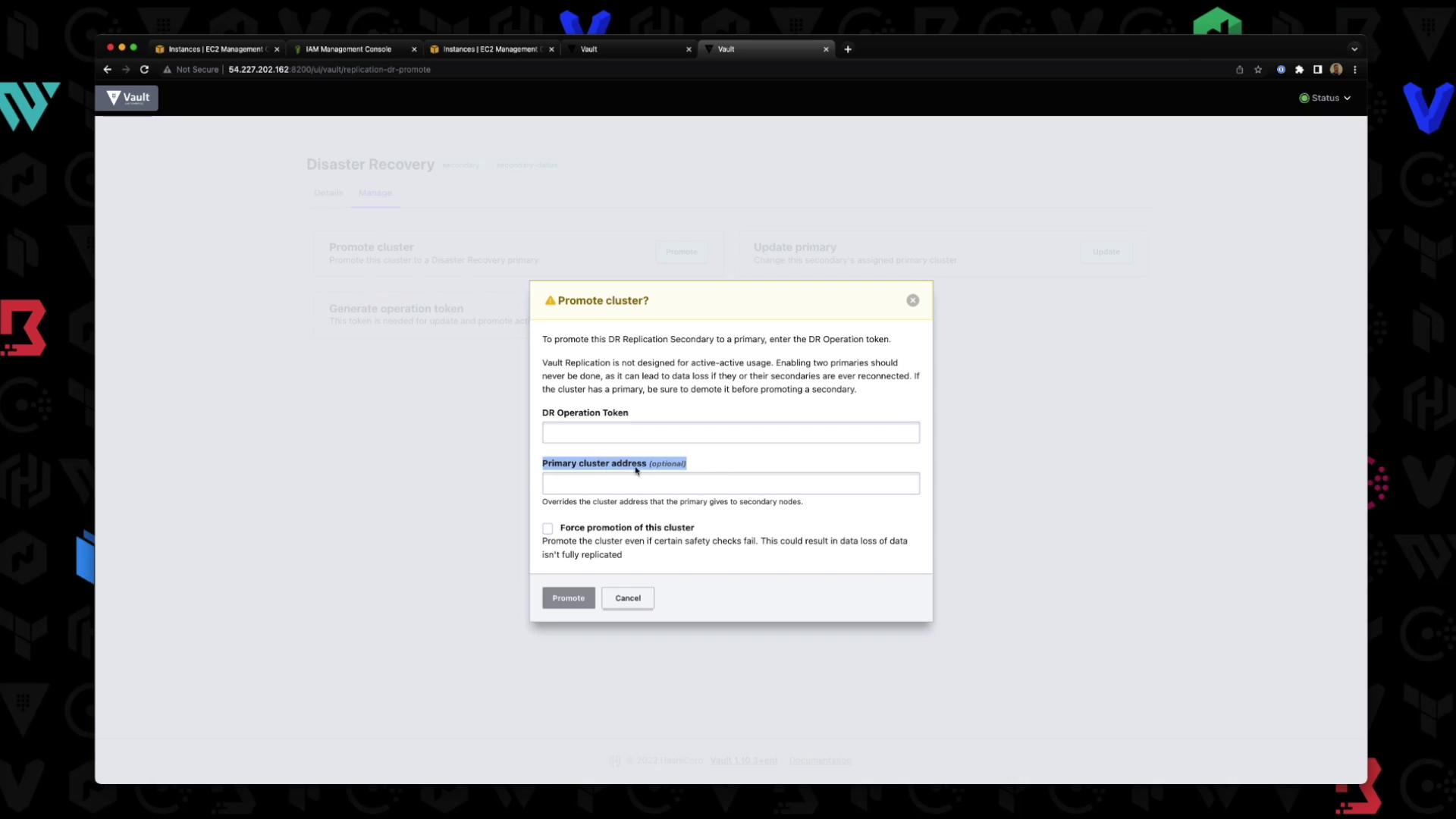
Command Summary
| Step | Command | Description |
|---|---|---|
| 1. Check Status | vault read sys/replication/status | View current DR & performance mode |
| 2. Enable Primary DR | vault write -force sys/replication/dr/primary/enable | Activate DR on primary |
| 3. Generate Secondary Token | vault write -f sys/replication/dr/primary/secondary-token | Create a one-time token for secondary |
| 4. Enable Secondary DR | vault write -f sys/replication/dr/secondary/enable | Connect secondary to primary |
| 5. Verify Secondary | vault read -format=json sys/replication/status | Confirm secondary is streaming WALs |
| 6. Verify Primary | vault read -format=json sys/replication/status | List connected secondaries |
Links and References
Watch Video
Watch video content
Practice Lab
Practice lab